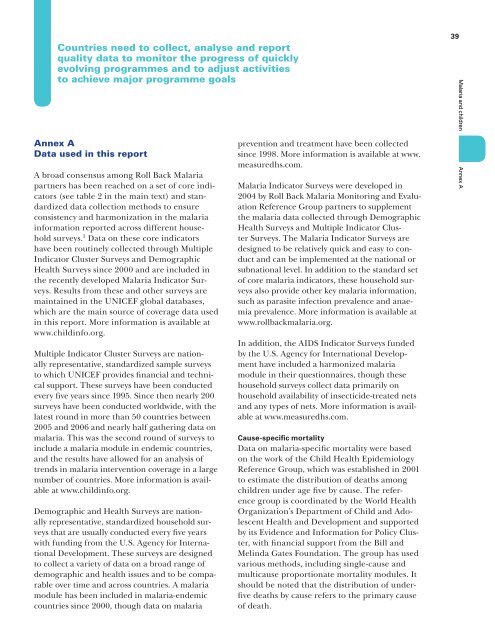Malaria and children: Progress in intervention coverage - Unicef
Malaria and children: Progress in intervention coverage - Unicef
Malaria and children: Progress in intervention coverage - Unicef
Create successful ePaper yourself
Turn your PDF publications into a flip-book with our unique Google optimized e-Paper software.
Countries need to collect, analyse <strong>and</strong> report<br />
quality data to monitor the progress of quickly<br />
evolv<strong>in</strong>g programmes <strong>and</strong> to adjust activities<br />
to achieve major programme goals<br />
Annex A<br />
Data used <strong>in</strong> this report<br />
A broad consensus among Roll Back <strong>Malaria</strong><br />
partners has been reached on a set of core <strong>in</strong>dicators<br />
(see table 2 <strong>in</strong> the ma<strong>in</strong> text) <strong>and</strong> st<strong>and</strong>ardized<br />
data collection methods to ensure<br />
consistency <strong>and</strong> harmonization <strong>in</strong> the malaria<br />
<strong>in</strong>formation reported across different household<br />
surveys. 1 Data on these core <strong>in</strong>dicators<br />
have been rout<strong>in</strong>ely collected through Multiple<br />
Indicator Cluster Surveys <strong>and</strong> Demographic<br />
Health Surveys s<strong>in</strong>ce 2000 <strong>and</strong> are <strong>in</strong>cluded <strong>in</strong><br />
the recently developed <strong>Malaria</strong> Indicator Surveys.<br />
Results from these <strong>and</strong> other surveys are<br />
ma<strong>in</strong>ta<strong>in</strong>ed <strong>in</strong> the UNICEF global databases,<br />
which are the ma<strong>in</strong> source of <strong>coverage</strong> data used<br />
<strong>in</strong> this report. More <strong>in</strong>formation is available at<br />
www.child<strong>in</strong>fo.org.<br />
Multiple Indicator Cluster Surveys are nationally<br />
representative, st<strong>and</strong>ardized sample surveys<br />
to which UNICEF provides f<strong>in</strong>ancial <strong>and</strong> technical<br />
support. These surveys have been conducted<br />
every five years s<strong>in</strong>ce 1995. S<strong>in</strong>ce then nearly 200<br />
surveys have been conducted worldwide, with the<br />
latest round <strong>in</strong> more than 50 countries between<br />
2005 <strong>and</strong> 2006 <strong>and</strong> nearly half gather<strong>in</strong>g data on<br />
malaria. This was the second round of surveys to<br />
<strong>in</strong>clude a malaria module <strong>in</strong> endemic countries,<br />
<strong>and</strong> the results have allowed for an analysis of<br />
trends <strong>in</strong> malaria <strong>in</strong>tervention <strong>coverage</strong> <strong>in</strong> a large<br />
number of countries. More <strong>in</strong>formation is available<br />
at www.child<strong>in</strong>fo.org.<br />
Demographic <strong>and</strong> Health Surveys are nationally<br />
representative, st<strong>and</strong>ardized household surveys<br />
that are usually conducted every five years<br />
with fund<strong>in</strong>g from the U.S. Agency for International<br />
Development. These surveys are designed<br />
to collect a variety of data on a broad range of<br />
demographic <strong>and</strong> health issues <strong>and</strong> to be comparable<br />
over time <strong>and</strong> across countries. A malaria<br />
module has been <strong>in</strong>cluded <strong>in</strong> malaria-endemic<br />
countries s<strong>in</strong>ce 2000, though data on malaria<br />
prevention <strong>and</strong> treatment have been collected<br />
s<strong>in</strong>ce 1998. More <strong>in</strong>formation is available at www.<br />
measuredhs.com.<br />
<strong>Malaria</strong> Indicator Surveys were developed <strong>in</strong><br />
2004 by Roll Back <strong>Malaria</strong> Monitor<strong>in</strong>g <strong>and</strong> Evaluation<br />
Reference Group partners to supplement<br />
the malaria data collected through Demographic<br />
Health Surveys <strong>and</strong> Multiple Indicator Cluster<br />
Surveys. The <strong>Malaria</strong> Indicator Surveys are<br />
designed to be relatively quick <strong>and</strong> easy to conduct<br />
<strong>and</strong> can be implemented at the national or<br />
subnational level. In addition to the st<strong>and</strong>ard set<br />
of core malaria <strong>in</strong>dicators, these household surveys<br />
also provide other key malaria <strong>in</strong>formation,<br />
such as parasite <strong>in</strong>fection prevalence <strong>and</strong> anaemia<br />
prevalence. More <strong>in</strong>formation is available at<br />
www.rollbackmalaria.org.<br />
In addition, the AIDS Indicator Surveys funded<br />
by the U.S. Agency for International Development<br />
have <strong>in</strong>cluded a harmonized malaria<br />
module <strong>in</strong> their questionnaires, though these<br />
household surveys collect data primarily on<br />
household availability of <strong>in</strong>secticide-treated nets<br />
<strong>and</strong> any types of nets. More <strong>in</strong>formation is available<br />
at www.measuredhs.com.<br />
Cause-specific mortality<br />
Data on malaria-specific mortality were based<br />
on the work of the Child Health Epidemiology<br />
Reference Group, which was established <strong>in</strong> 2001<br />
to estimate the distribution of deaths among<br />
<strong>children</strong> under age five by cause. The reference<br />
group is coord<strong>in</strong>ated by the World Health<br />
Organization’s Department of Child <strong>and</strong> Adolescent<br />
Health <strong>and</strong> Development <strong>and</strong> supported<br />
by its Evidence <strong>and</strong> Information for Policy Cluster,<br />
with f<strong>in</strong>ancial support from the Bill <strong>and</strong><br />
Mel<strong>in</strong>da Gates Foundation. The group has used<br />
various methods, <strong>in</strong>clud<strong>in</strong>g s<strong>in</strong>gle-cause <strong>and</strong><br />
multicause proportionate mortality modules. It<br />
should be noted that the distribution of underfive<br />
deaths by cause refers to the primary cause<br />
of death.<br />
39<br />
<strong>Malaria</strong> <strong>and</strong> <strong>children</strong> Annex A<br />
3
















